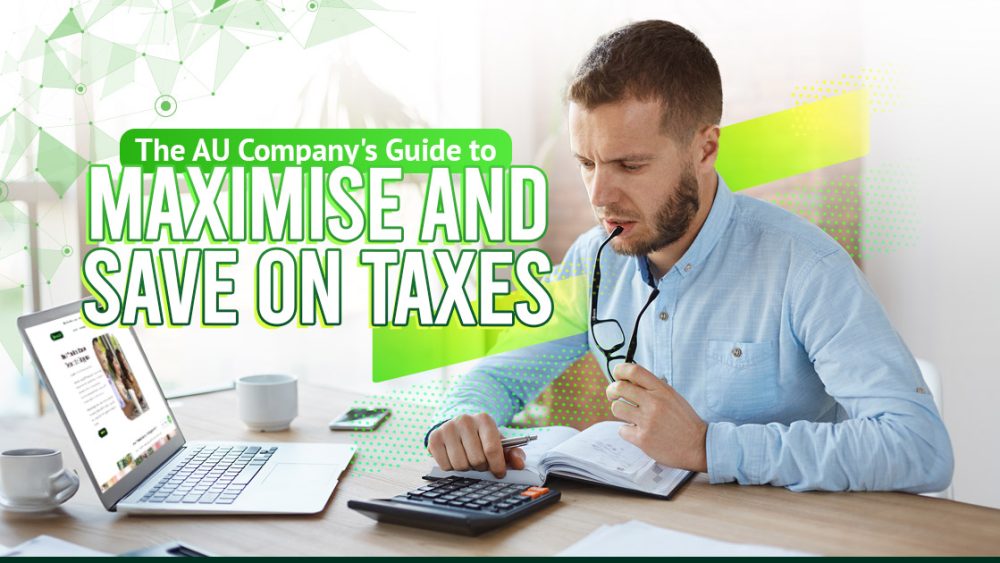Tax planning is important, regardless of your income level. It’s even more crucial for business owners. In the local scene, Australian small and medium enterprises (SMEs) can benefit a lot from effective tax planning.
By understanding the tax code, businesses can utilise available deductions, credits, and strategies relevant to their respective industries.
However, complex regulations, lack of internal expertise, and constantly changing laws can pose significant challenges, creating the need for proper tax planning.
Understanding Australian Tax Obligations for SMEs
Australia implements a federal tax system, enabling both the federal government and the state governments to levy various taxes. The Australian Taxation Office (ATO) administers a system designed to be progressive, redistributive, and fair, with higher-income earners contributing more.
Federal taxes consist of direct taxes like income tax and indirect taxes which include goods and services tax (GST). On the other hand, state taxes usually cover payroll tax, stamp duty, land, motor vehicle, and gambling taxes, among others.
Overview of SME Taxation in Australia
The AU government subjects all companies’ taxable income to a federal tax rate of 30%. However, SMEs are given a reduced tax rate of 25%.
Businesses earning less than $50-million annually qualify as SMEs, subjecting them to relatively lower taxes. Meanwhile, GST follows a flat rate of 10% which is normally added to the base price of a product or service.
All small businesses registered as a company are also required to pay company tax. The total amount of tax payable would depend on business type, gross and passive income, applicable concessions, and other factors relevant to the industry.
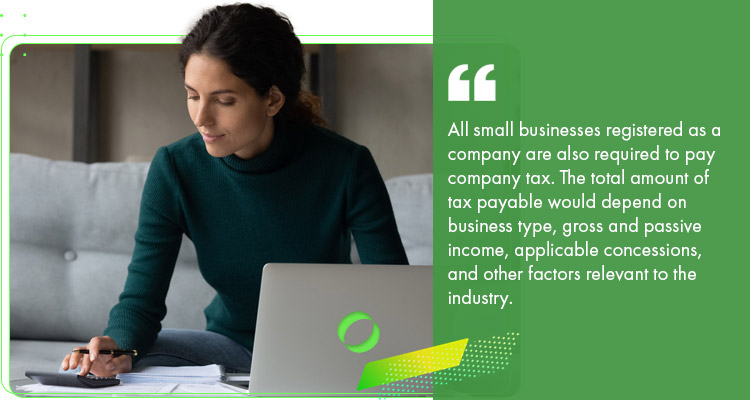
Explanation of the tax considerations for SMEs in Australia
AU tax laws allow SMEs to claim a deduction for the cost of properties or assets under the instant asset write-off.
Most SMEs must also register for GST and lodge a regular Business Activity Statement (BAS) with the Australian Taxation Office.
On the other hand, SMEs must pay income tax on the net business profit in a financial year which is income minus deductible business expenses. Private expenses cannot be claimed hence, there must be records to support the allowable deductions.
In some cases, SMEs also have to pay for the fringe benefits tax (FBT), which applies to company cars or free meals companies provide their employees on top of their salary.
Common tax obligations and potential pitfalls to avoid
SMEs are required to register for an Australian Business Number (ABN). They’re also liable for paying income tax on their taxable income.
On top of that, businesses are required to contribute a minimum percentage of their employees’ salary towards their retirement savings (superannuation).
Non-compliance with the above may result in legal sanctions or costly penalties.
Thus, SMEs should avoid the following pitfalls:
- Failing to register for the correct taxes – Failing to register can lead to legal actions, fines, business suspension, and closure;
- Missing tax deadlines – Late payments of income tax returns, BAS statements, or activity statements can incur penalties and other legal obligations;
- Poor record-keeping – The AU government may require records for several years and poor bookkeeping can result in ATO inquiries;
- Failing to seek professional advice – Navigating the complex tax system without professional guidance can result in costly errors or missed deductions;
- Overlooking state taxes – Some businesses forget state-specific taxes after complying with federal tax obligations;
- Unfamiliarity with deductible expenses – Without enough tax knowledge, businesses may fail to claim deductions for legitimate business expenses; and
- Missing out on tax concessions – SMEs often fail to avail of tax breaks including asset write-offs, simplified depreciation rules, and other benefits.
Key Tax Dates and Deadlines
Filing taxes on time is crucial to avoid tax liabilities. This requires AU SMEs to keep track of key deadlines on ATO’s website.
Important tax dates and deadlines SMEs must adhere to
AU SMEs should take note of the following key dates:
- 28th of the month following the quarter: Deadline to lodge quarterly Business Activity Statements
- 15th January: Deadline for income tax returns for companies with a taxable income exceeding $10 million in the previous year
- 28th February – Deadline for income tax returns of other businesses that do not qualify for the 15th January filing
- 21st of the following month: Deadline for monthly Pay As You Go instalments for employers
- Varying throughout the year: Deadlines for tax returns, fringe benefits tax, and other obligations
Tips for timely tax planning and submission
Timely tax planning is critical, so AU businesses should plan strategically to maximise and save on taxes.
- Understand Tax Obligations. AU SMEs should familiarise themselves with the taxes they’re liable for and their corresponding deadlines.
- Prepay Allowable Expenses. Consider prepaying certain allowable expenses before the end of the financial year, bringing them into the current tax year for deductions.
- File Early. SMEs should file tax returns and BAS statements well before the due dates, avoiding last-minute stress and potential penalties.
Tax Planning Strategies for SMEs to Maximise and Save on Taxes
Aside from Tracking income and expenses meticulously, Understanding their business structure; and seeking professional advice, among others.
Australian SMEs can save and maximise on taxes by:
Maximising Tax Deductions
Tax deductions are legitimate ways of reducing taxable income, ultimately lowering the tax payable. In Australia, SMEs are allowed to deduct business-related expenses as long as they provide records to substantiate these claims.
Businesses should avail tax deductions to lower tax liability. By claiming all allowable deductions, they would have more cash flow for business growth, investments, and distribution of profits. Minimising the tax burden would also boost a company’s net income, providing a safety net in case of economic downturns or unexpected expenses.
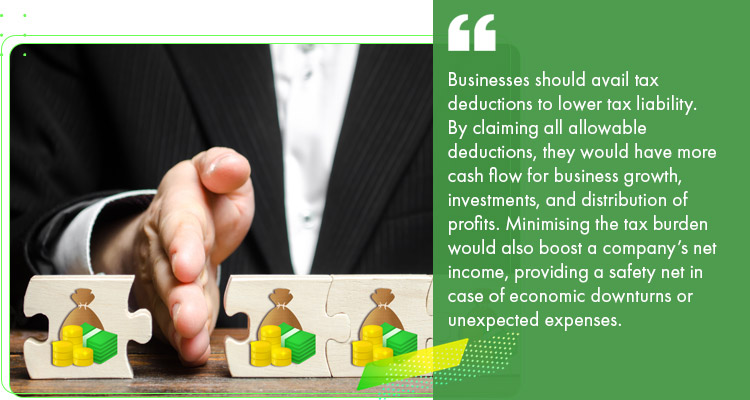
Allowable deductions for SMEs to maximise and save on taxes
The Australian Taxation Office provides a list of allowable deductions for small business owners.
According to its website, small businesses can claim a deduction for most costs incurred in running the business such as staff wages, marketing, and business finance costs.
SMEs can also claim business travel expenses, including:
- Airfares, train, tram, bus, or taxi fares;
- Accommodation costs and meal expenses for overnight business travel; and
- Home-based businesses can claim the business portion of some expenses including mortgage interest and electricity.
How to document and claim allowable deductions effectively
The ATO website provides guides and forms to assist businesses and entrepreneurs throughout the process of claiming deductions:
1. Gather Relevant Documents. This includes bank statements, receipts, invoices, and other documentation that attests to business-related expenses.
2. Complete the Required Fields. Each document should state the date, supplier name, description, amount paid, and payment method.
3. Store Documents. Consider scanning physical receipts and invoices for digital storage, and keeping originals for potential audits.
4. Identify Relevant Deductions. Refer to ATO guidelines regarding tax-deductible expenses for a specific business type.
5. Choose the Appropriate Method. Australian SMEs can claim deductions through their tax returns or by engaging a registered tax agent for assistance.
Utilising Business Losses
Australian SMEs can carry business losses forward to offset future income in subsequent years.
Done right, it can allow businesses to reduce their tax liabilities with the losses from previous years. More importantly, SMEs can carry forward these losses in a later year as long as they meet all the requirements.
It’s also crucial to note that losses are generally used in a first-in, first-out basis. This means businesses have to utilise losses from earlier years before offsetting them with more recent losses. However, losses can be generally carried forward indefinitely as long as the business remains operational.
Strategies for carrying forward business losses for tax returns
Most AU SMEs are eligible to carry forward business losses. Under the law, businesses must carry forward their business losses from the previous year to the current or future year before lodging their tax returns.
Offset rules and how they can reduce taxable income
Tax offsets directly reduce taxes owed after calculating the taxable income.
- A sole trader or individual partner can offset current business losses against other income in the same income year.
- There must be an accurate reconciliation of losses carried forward from a prior year to a later year.
- The business must not categorise expenses like capital expenditure losses as normal expenses.
While offsets do not reduce a business’s taxable income, they can directly reduce the amount of taxes payable.
In other words, offsets can help reduce AU SME’s overall tax burden, potentially increasing their net income.
Small Business Tax Concessions
AU tax laws also offer a range of tax concessions designed to support and empower small businesses. These concessions can help reduce tax liability, improving cash flow and allowing businesses to reinvest more funds. By availing these concessions, AU small and medium enterprises can ease their tax burden, encouraging growth and expansion.
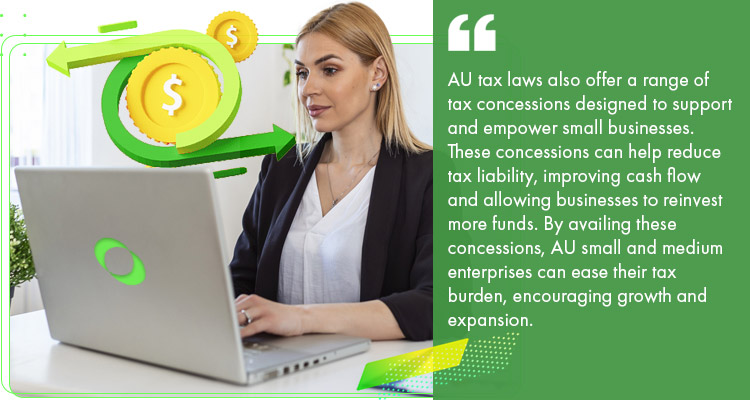
Eligibility for these concessions is based on turnover thresholds. In other words, businesses can combine their total revenue from all business activities over 12 months to see if they would qualify for income tax concessions.
Detailed analysis of tax concessions available to SMEs
Small and medium enterprises are the backbone of many economies.
Thus, there are a range of concessions Down Under to help eligible businesses maximise and save on taxes, such as:
- Reduced income tax rates;
- Tax exemptions;
- Tax deductions and credits; and
- Simplified compliance.
Eligibility criteria and application process
Australian sole traders, partnerships, companies, and trusts can access the following concessions based on their aggregated turnover:
- Less than $2 million – Eligible for small business CGT concessions
- Less than $5 million – Can avail of the small business income tax offset
- Less than $10 million – Qualifies for the small business restructure roll-over
SMEs must check their eligibility before applying since each concession has different requirements.
Investment and Growth Opportunities
The Australian SME sector offers a dynamic environment for businesses to thrive.
Various government initiatives provide support for innovation and funding. There are also tax incentives if a company engages in research and development initiatives.
Tax Considerations for Business Investments
Businesses must invest in growth opportunities, while keeping the corresponding tax implications in mind.
Considering taxes throughout the investment lifecycle is crucial. Capital allowances, for example, allow businesses to claim depreciation deductions, spreading the cost of the asset over its useful life and reducing the taxable income each year. Failing to consider tax implications can lead to business losses, penalties, or ATO audits.
How investment decisions impact SME taxation
Strategic investments can significantly reduce tax burdens so you can maximise and save on taxes. Conversely, poorly planned investments can lead to higher tax liabilities.
Regardless of whatever decisions or investments a company makes, there are always tax implications to consider. Thus, following ATO guidelines is essential for Australian SMEs to maintain good standing with the tax authorities. By adhering to these guidelines, businesses can make informed decisions regarding the tax consideration of every investment decision.
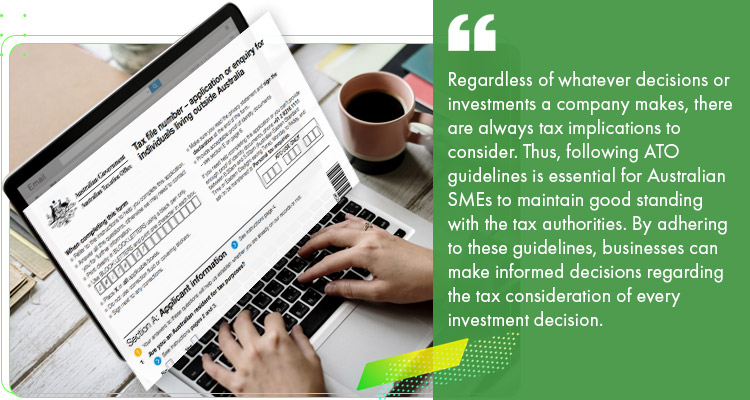
For instance, AU SMEs can lower their taxable income by:
- Using the right business structure;
- Writing off bad debts;
- Claiming all tax deductions; and
- Accounting for asset depreciation.
Meanwhile, they can also generate tax-advantaged returns to reduce their tax burden.
These include research and development tax incentives, capital gains tax discounts, and the dividend imputation system.
With the right approach, Australian SMEs will have better chances of maximising their tax breaks.
Balancing growth with tax-efficient investment strategies
SMEs must focus on their core business functions by investing in marketing and sales, technology, innovation, and product development.
On the other hand, they must not lose sight of tax-efficient investment measures like tax deductions and credits and simplified tax filing procedures.
Combined, these strategies can ensure that investments will support the company’s overall growth strategy.
R&D Tax Incentives for SMEs
As mentioned above, the Australian government helps companies “innovate and grow by offsetting some of the costs of eligible research and development.”
Benefits of the R&D tax incentive for SMEs
The R&D Tax Incentive provides several key benefits for AU SMEs.
- Reduced Tax Bill. The incentive offers refundable tax offsets for eligible companies, improving cash flow which is crucial for SMEs.
- Increased Tax Deductions. It also lowers the company’s overall tax liability, enabling businesses to invest further.
- Improved Global Competitiveness. With government-subsidised research and development, Australian SMEs can compete globally with its innovative offerings.
- Incentivised Research. The incentive also encourages SMEs to allocate more resources towards research and development, fostering a culture of innovation.
- Multi-sector Collaboration. SMEs can partner with universities and research institutions, enabling them to access specialised expertise and facilities.
How to qualify and claim the incentive
Australian SMEs can qualify and claim their R&D Tax Incentive if they are:
- Registered as a company and subject to Australian income tax;
- Developing new knowledge or process; and
- Spending at least $20,000 for research and development.
The law requires businesses to conduct a self-assessment to claim the incentive. This includes determining if their activities meet the eligibility criteria.
If so, the company will register, providing details of its R&D activities and expenses.
Remote Staff’s Role in SME Tax Optimisation
Australian SMEs and entrepreneurs can tap Tax outsourcing providers like Remote Staff to assist with bookkeeping, accounting, and tax compliance.
They can also match businesses with the right virtual assistant, admin assistant, who can assist in preparing tax-related documents and help you maximise and save on taxes.
Introduction to Remote Staff’s Accounting Talent
Many AU SMEs outsource accounting tasks to a professional bookkeeper or accountant for better scalability and flexibility.
Remote Staff, for example, has over 16 years of experience providing AU businesses with skilled Filipino remote workers who are adept at various accounting services.
Overview of Remote Staff and the specialised accounting services SMEs outsource through them
Remote Staff has a roster of Filipino professionals who can help with:
- Bookkeeping
- Tax Services
- Payroll Processing
- Financial Reporting
- Fraud Detection and Prevention
- Financial Statement Audits
- Compliance Procedures
By delegating these accounting tasks, business owners can focus on core activities that really drive growth, particularly sales, marketing, and product development.
- Want specific AI Prompts to help you automate processes? Get the Full AI list here.
- How about a list of the Top Business Apps that could take your company to the next level this 2024? Head over here.
- Whenever you are ready to Hire World-Class, High Performing, Full-Time Virtual Staff at 40%-60% Cost Savings with Lifetime Support head over here.
- View our 1,000 Fully vetted, highly talented virtual staff who can take the more tedious tasks off your hands here.
Syrine is studying law while working as a content writer. When she’s not writing or studying, she engages in tutoring, events planning, and social media browsing. In 2021, she published her book, Stellar Thoughts.

